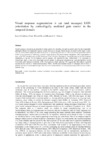Visual response augmentation in cat (and macaque) LGN: potentiation by corticofugally mediated gain control in the temporal domain

View/
Use this link to cite
http://hdl.handle.net/2183/14591Collections
- Investigación (FCS) [1293]
Metadata
Show full item recordTitle
Visual response augmentation in cat (and macaque) LGN: potentiation by corticofugally mediated gain control in the temporal domainDate
2001-12-24Citation
Cudeiro J, Rivadulla C, Grieve KL. Visual response augmentation in cat (and macaque) LGN: potentiation by corticofugally mediated gain control in the temporal domain. Eur J Neurosci. 2001;12(4):1135-44.
Abstract
[Abstract] Visual responses of neurons are dependent on the context of a stimulus, not only in spatial terms but also temporally, although evidence for temporally separate visual influences is meagre, based mainly on studies in the higher cortex. Here we demonstrate temporally induced elevation of visual responsiveness in cells in the lateral geniculate nucleus (LGN) of cat and monkey following a period of high intensity (elevated contrast) stimulation. This augmentation is seen in 40–70% (monkey–cat) of cells tested and of all subtypes. Peaking at ∼ 3 min following the period of intense stimulation, it can last for 10–12 min and can be repeated and summed in time. Furthermore, it is dependent on corticofugal input, is seen even when high contrast stimuli of orthogonal orientation are used and therefore results from a/any prior increase in activity in the retino-geniculo-striate pathway. We suggest that this reflects a general mechanism for control of visual responsiveness; both a flexible and dynamic means of changing effectiveness of thalamic activity as visual input changes, but also a mechanism which is an emergent property of the thalamo-cortico-thalamic loop.
Keywords
Context dependent
Contrast mediated
Cortico-geniculate
Response enhancement
Thalamo-cortico-thalamic loop
Contrast mediated
Cortico-geniculate
Response enhancement
Thalamo-cortico-thalamic loop
Editor version
Rights
This is the peer reviewed version of the following article which has been published in final form at Wiley Online Library. This article may be used for non-commercial purposes in accordance with Wiley Terms and Conditions for self-archiving.





